OrthoPets Veterinary Orthotics and Prosthetics
Stifle Solutions

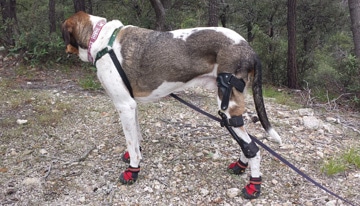
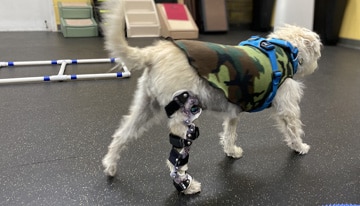
The OrthoPets stifle orthosis is one of our most popular devices. It’s ideal for cruciate and collateral ligament injuries where surgery isn’t an option for health or other reasons. The device can also be used in support of extra-capsular imbrication techniques, especially in cases of larger dogs where sutures have a higher failure rates.
This stifle orthosis is also appropriate for mild to moderate (grade 1& 2) patella luxation cases. The brace allows for articulation along a normal plane while preventing rotational, medial/lateral and cranial/cruciate movement at the joint.
Force Coupling
This unique animal orthosis uses force coupling to support the stifle joint — not a 3-point corrective system. Force coupling depends on normal contraction of the quadriceps, hamstrings and gastrocnemius.
In a weight-bearing stance, the proximal shell is pulled onto the thigh with the contraction of the quads and hamstrings making the proximal limb and shell one unit. As the gastrocs contract, the distal shell is pulled onto the distal limb, again, forming a single unit. The anatomical and mechanical hinges are aligned and movement of the proximal and distal limb segments are limited by the mechanical hinge. The gastroc contraction creates a caudally directed force against the proximal tibia, preventing painful drawer motion common in CCL injuries.
Common Applications
-
Cruciate and collateral ligament tears
-
Pivot shift instability
-
Tibial crest fractures
-
Luxating patella (up to Grade 2-3)
-
Arthritis
Carpus
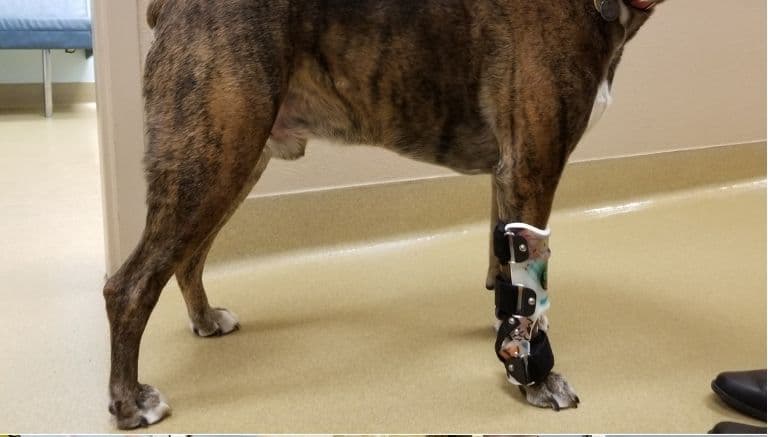

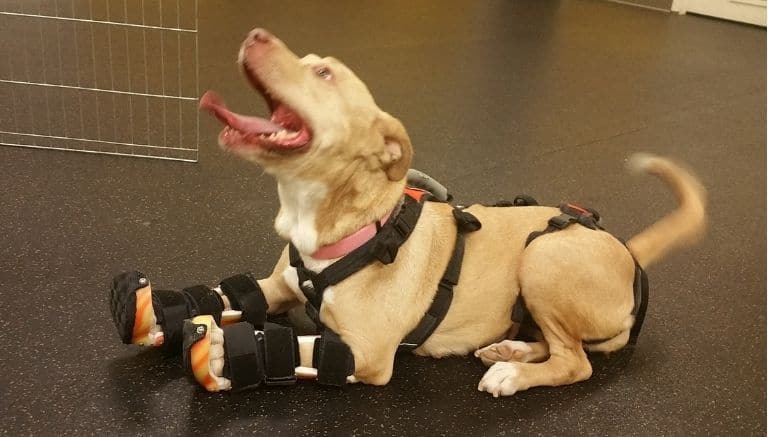
The OrthoPets carpus orthosis is commonly used for hyperextension injuries, instances of general palmigrade collapse or medial/lateral instabilities, as well as varus/valgus deformities.
Carpus mechanics depend on a 2-phase pressure curve. First, ground forces are transmitted to the carpus. Second, that force is absorbed by palmar fibrocartilage in the normal carpus. In the case of hyperextension, the palmar fibrocartilage cannot adequately resist the caudally-directed force and the joint collapses.
Mild to Moderate Hyperextension
In most cases of mild to moderate hyperextension, an articulating carpal orthosis without a paw segment will often provide the necessary stability without disturbing a dog’s proprioception.
The device allows for normal range of flexion movement, but when the joint returns to a neutral standing position, a motion limiter prevents the joint from breaking into hyperextension. Ground ground forces are transferred through the paw and into the mechanical hinge at the carpus. The articulating shell locks and the force is transmitted to the proximal antebrachium.
Severe or Multi-plane Instability
In cases of bi- or tri-planar instability, a non-articulating device with a paw segment is often appropriate. A 3-point corrective system places counter forces at the antebrachium and paw which oppose corrective forces at the carpal joint to provide the necessary stability.
Common Applications
-
Hyperextension injuries
-
Medial/lateral instability
-
Brachial Plexus nerve injury
-
Radial nerve damage
-
Neurological positioning control
-
Osteosarcoma
Tarsus
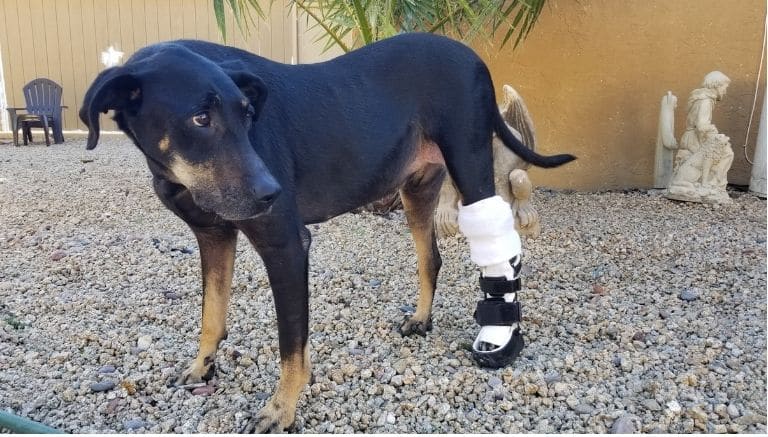
The OrthoPets progressive dynamic tarsus orthosis is available with multiple levels of articulation to accommodate a wide range of cases. This device can provide three configurations in a single device, depending on the severity of the injury and surgical status.
Ideal for Achilles tendon injuries, this device as an alternative to serial splinting and where progressive articulation is invaluable in the healing process. This device is also appropriate for general plantar grade collapse, medial/lateral instability or hyperextension.
Achilles Complex Injuries
Intended Outcome: Repaired/Healed Tendon
The foundational device is non-articulating in tarsal extension, with the motion limiter at zero. This device can be used from post-op through approximately the first eight weeks of recovery.
When gradually increasing levels of articulation are appropriate, the motion limiter is decreased to allow greater range of motion and the paw segment is eventually removed at some point between week 8 and week 20. As this point, the device can be used as a sports device for periods of high-intensity activity.
Non-Surgical or Severe Injury to Tendon
Intended Outcome: Long-Term Support
The foundational device is non-articulating in tarsal extension. Because no articulation is expected, the device is solid and without hinges. This device prevents plantigrade collapse. Removable corrective paw wedges are used in the case of SDF contracture.
Common Applications
-
Achilles tendon tears
-
Digital Flexor tendon injuries
-
Hyperextention injuries
-
Medial/lateral instability
-
Toe amputation
-
Neurological positioning control
Elbow



The OrthoPets elbow orthosis is commonly used for general support by preventing medial and lateral rotational movement while still allowing movement along a normal plane. In more severe cases, the partial immobilization can help reduce pain caused by arthritis and elbow degenerative joint disease. A myriad of hinge options allow the opportunity to closely match the level of support and control needed to address the joint instability.
Common Applications
-
Joint instability
-
Partial immobilization for DJD or arthritis pain
-
Non-operable fractures
Prostheses



Fore- and rear-limb prostheses are available are a wide array of cases. Using a stump and socket system, these devices ensure a superb fit and provide unrivaled return to function for each patient. This system requires at least two functional joints in the limb (e.g., elbow and shoulder or stifle and hip).
Forelimb Solutions
Above-Carpus Prosthesis:
For elective amputations, pre-surgical planning is important. This prosthesis requires at least 40% of the radius/ulna for it to be a viable option. An adequate soft-tissue flap over the bottom surface of the bone is also important. If a congenital deformity exists some surgical revision may be required. The condition of the skin (post-surgical) should be considered before making the transition to the prosthesis.
Below-Carpus Prosthesis:
This option is common for elective amputations of the paw, congenital deformities and other conditions. Pre-surgical planning is also important here, however, not required.
Rear Limb Solutions
Below-Tarsus Prosthesis
For elective amputations, pre-surgical planning is important. This prosthesis requires the entire tibua/fibula including the malleoli for it to be a viable option. This option is also common for elective amputations of the paw, congenital deformities and other conditions. An adequate soft-tissue flap over the bottom surface of the bone is also important. If a congenital deformity exists some surgical revision may be required. The condition of the skin (post-surgical) should be considered before making the transition to the prosthesis.
Above-Tarsus Prosthesis
This options is available in a limited number of cases. The device is significantly more complicated and requires a very committed pet parent. If you have a case like this, please call and we can discuss the specifics.
Common Applications
-
Replacement limb for congenital deformity
-
Replacement limb for amputated limb segment
Toe-Up - Sciatic Nerve Sling
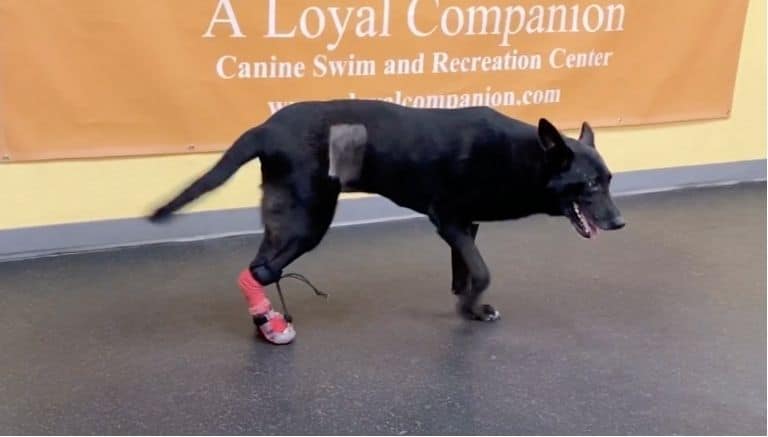

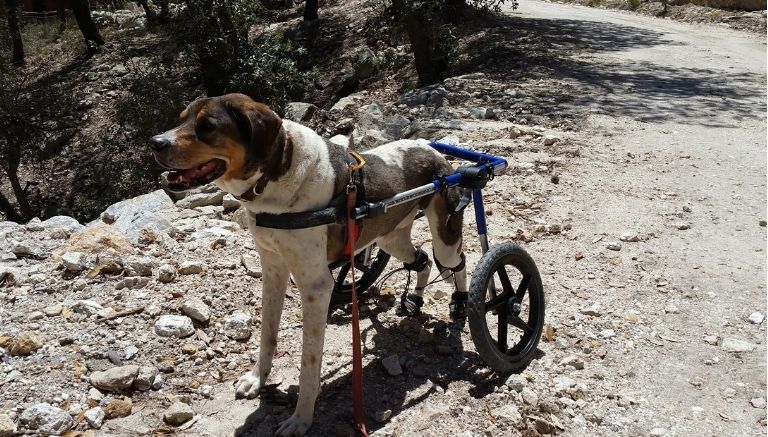
The OrthoPets Dynamic Sciatic Nerve Sling, or ToeUp, provides protection against trauma from scraping or dragging the paw while walking or running. The device provides variable tension so you can adjust the level of cranial swing support as the dog’s condition improves or worsens.
Proprioception is often impaired in these cases but can be improved through the tactile sensation of the boot, the proper paw alignment to the ground and the dynamic pull on the tarsus and related joints. It’s also a great hands-free method of developing proprioceptive neuromuscular facilitation (PNM) patterning. In short, the ToeUp helps the dog remember what their gait should look and feel like.
Common Applications
-
Degenerative Myelopathy
-
Spinal Trauma
-
Intervertebral Disc Disease (IVDD)
-
Neoplasia
-
Fibrocartilaginous embolus (FCE)
-
Surgical complication

